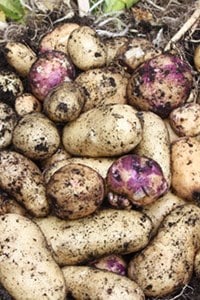Jobs of the month - April
Come rain or shine, April is a month of rapidly changing weather conditions often with a north/south split. Colder areas may lag several weeks behind milder ones at this time of year, so be sure to use the local weather conditions as your guide. During mild and dry spells you will be busy sowing, planting, watering, weeding and tackling early outbreaks of pests and diseases. It's all go in April!
Priority jobs...

- Get planting! Fill gaps in beds and borders by planting perennials, climbers and shrubs – including evergreens. As soon as temperatures increase, they will establish and grow away quickly. Choose a mild day when the soil is moist, but not waterlogged. Water the plants thoroughly, then remove the container before planting the rootball at the same depth as it was in the pot. Tease out a few roots if the rootball is densely compressed. Mulch the soil around the plant and water well.
- War on weeds It’s important to keep on top of weeds this month, so that they don’t have a chance to flower and set seed. Regular hoeing and hand weeding throughout the ‘weed window’ of April and May will go a long way to keeping your garden weed free for the rest of the year.
- TIME SAVER The temperature in a greenhouse will fluctuate rapidly as soon as the sun comes out at this time of year, so careful ventilation will be needed. Save time opening and shutting windows – and prevent your plants from frying - by installing automatic vent openers.
- Sow hardy annuals By mid-April you should be able to sow hardy annuals direct outside if the soil conditions allow. They are an excellent way of filling gaps in borders quickly and cheaply.
- Earth-up potatoes Protect the emerging shoots of potatoes from late frosts by dragging soil up over the row from each side. This is known as ‘earthing-up’. For added protection if a severe frost is forecast, have a sheet of gardening fleece handy to throw over the top.
- Control pests The first flush of growth will be targeted by sap-sucking pests, such as aphids (greenfly and blackfly). Check susceptible plants for signs of attack each time you walk around the garden and take remedial action as soon as a problem is noticed. Rub out or wash off small colonies and pinch off shoot tips the have been heavily infested to help prevent their spread.

Getting ahead...
- Secret supports Many large-flowered border perennials have a habit of flopping over just as they come into bloom. Before the new growth gets in the way, stake individual plants and put special linking stakes around clumps. Within a few weeks the supports will disappear from view under a surge of new growth.
- Plant hanging baskets Provided you have somewhere frost-free to keep the baskets, such as a greenhouse, conservatory or porch, until the threat of frost has passed, you can plant them now. By the time the baskets are positioned in the garden the plants will have filled the container and started to bloom.
- Feed permanent plants Scatter a general fertiliser, such as blood, bone and fishmeal, around established borders to give plants a boost.
- Prune early bloomers Deciduous shrubs, such as forsythia, that have finished flowering can be pruned now by removing one-in-three of the oldest stems.
Not too late to...

- Carry on mulching Cover bare soil between plants with a generous layer of well-rotted organic matter. This will not only help prevent weeds, but will keep the soil moist around plants’ roots.
- Make repeat sowings Make successional sowings of early carrots, lettuce, radish, and spring onions. Sow short rows every fortnight to achieve a continuous supply and to avoid gluts.
Happy gardening!
